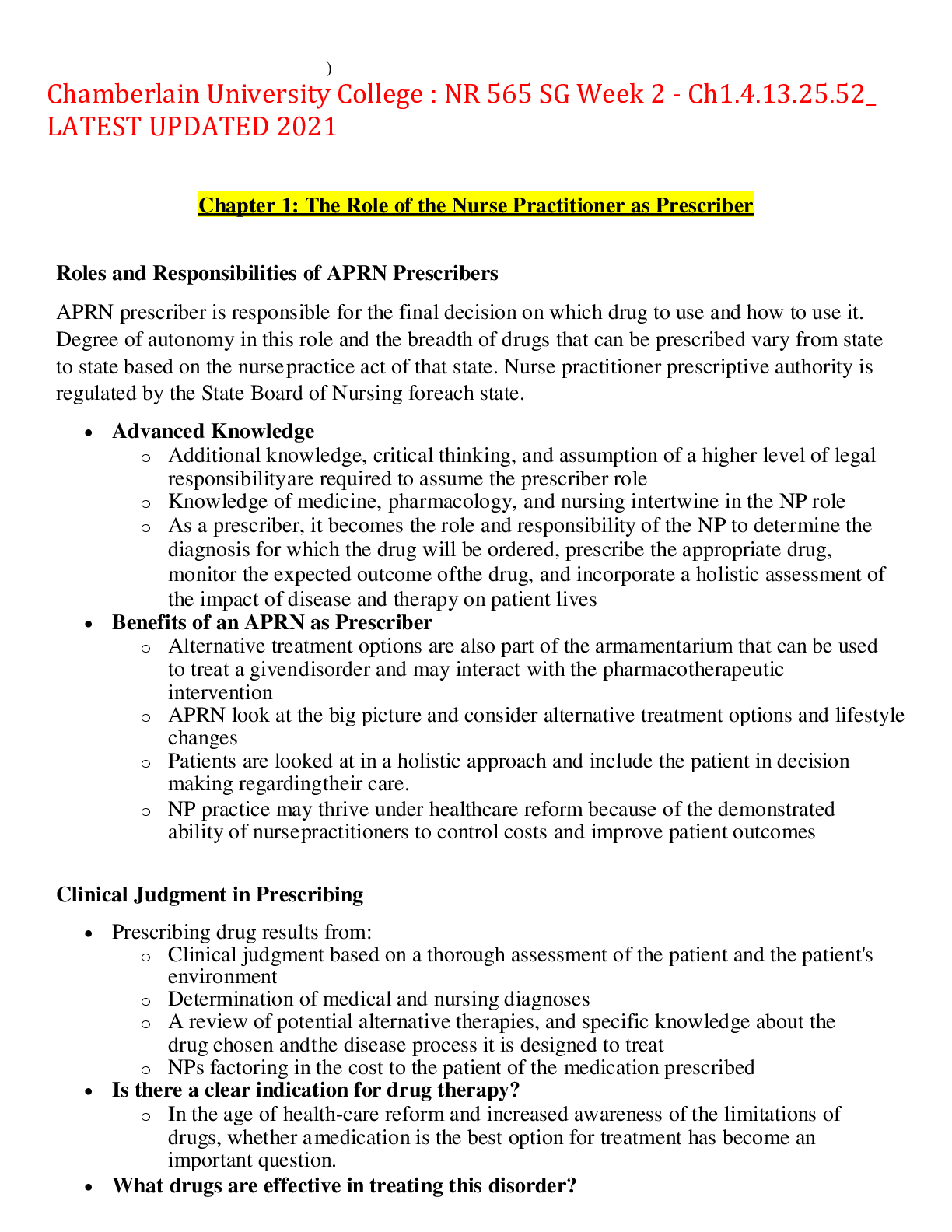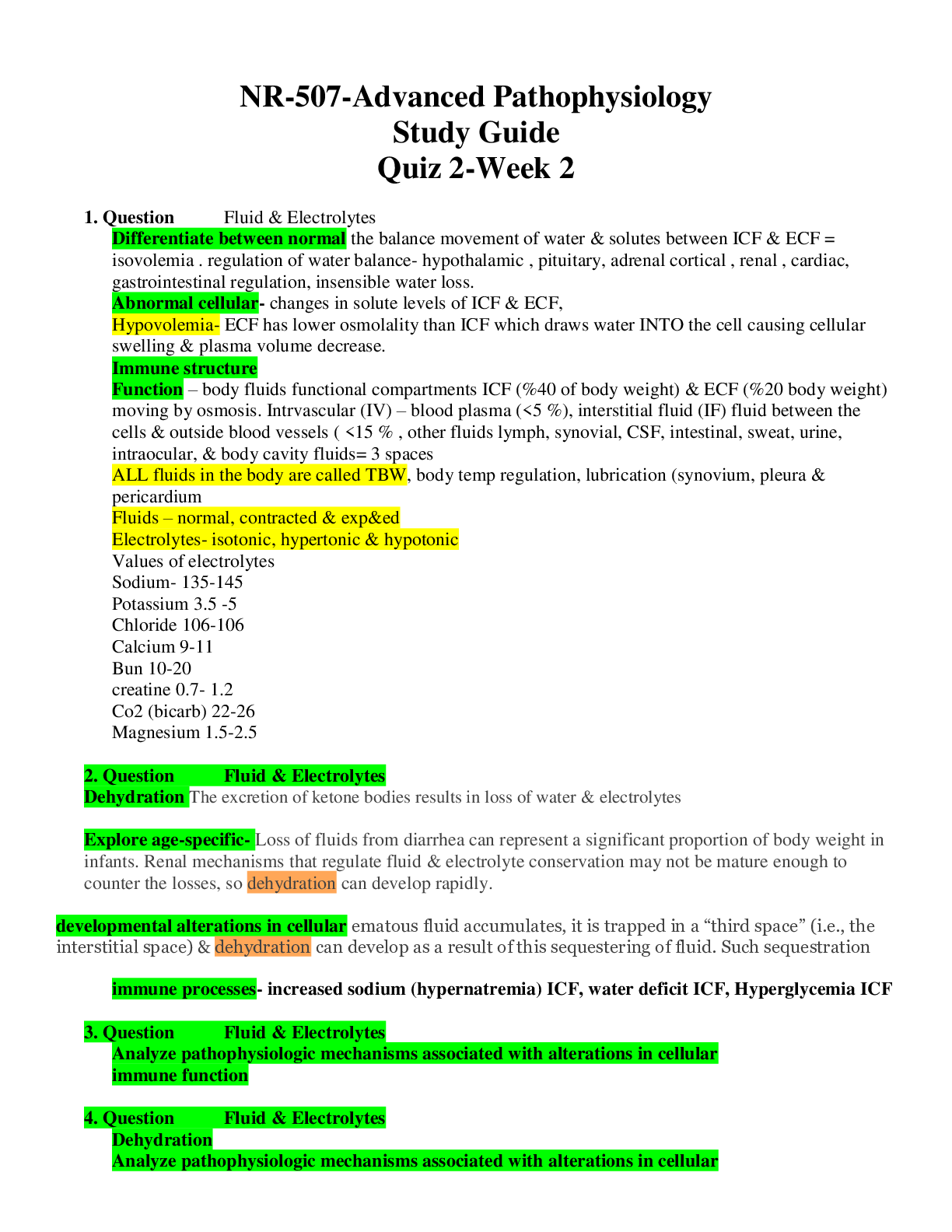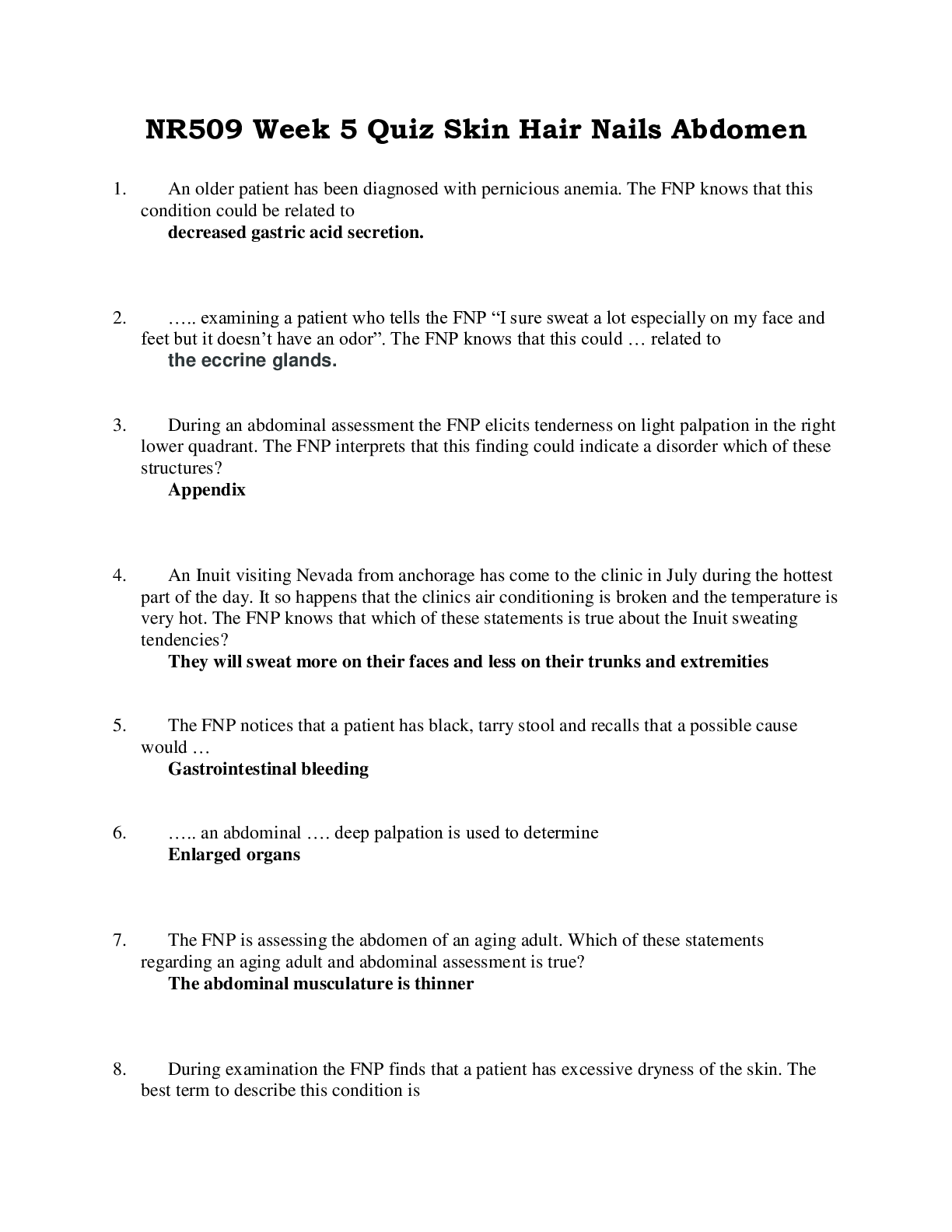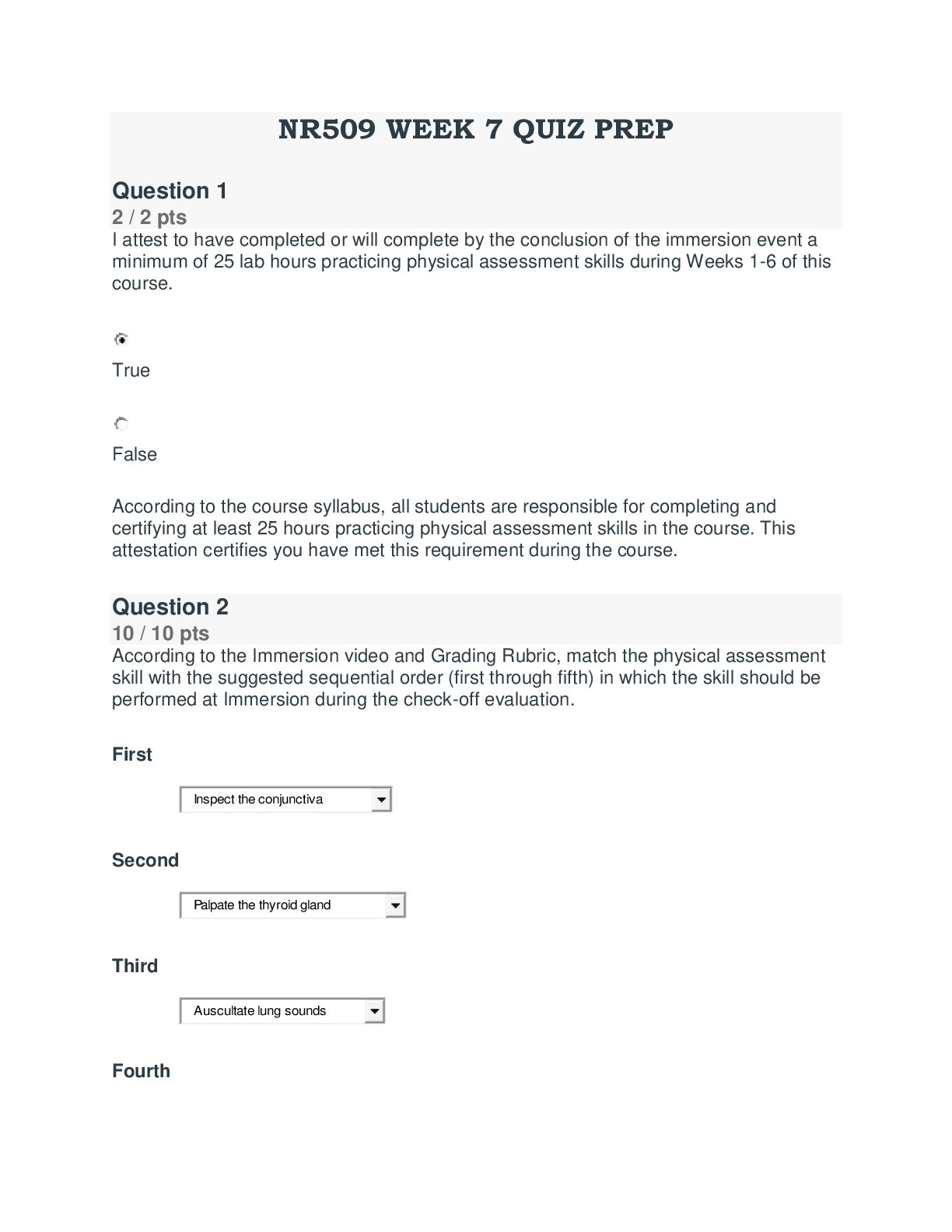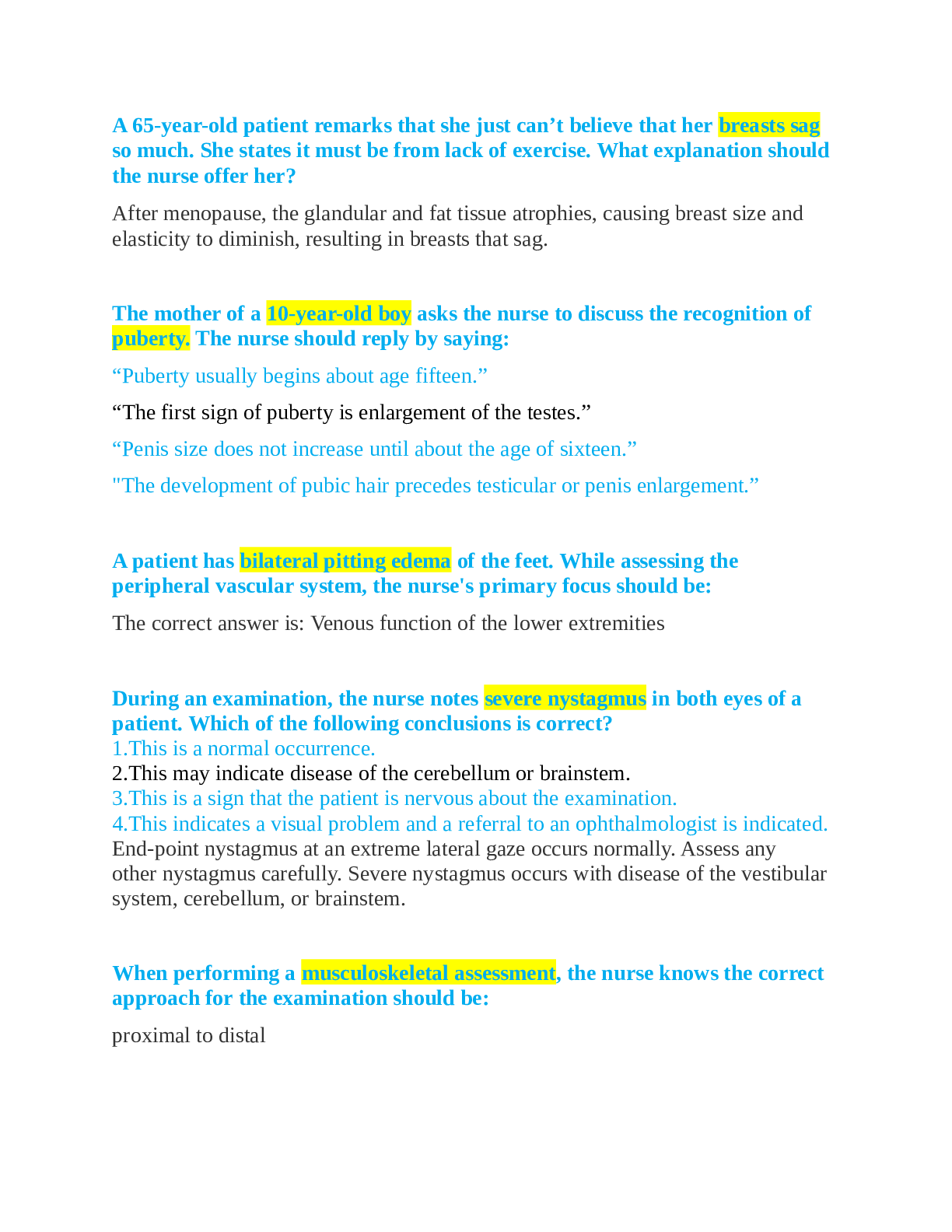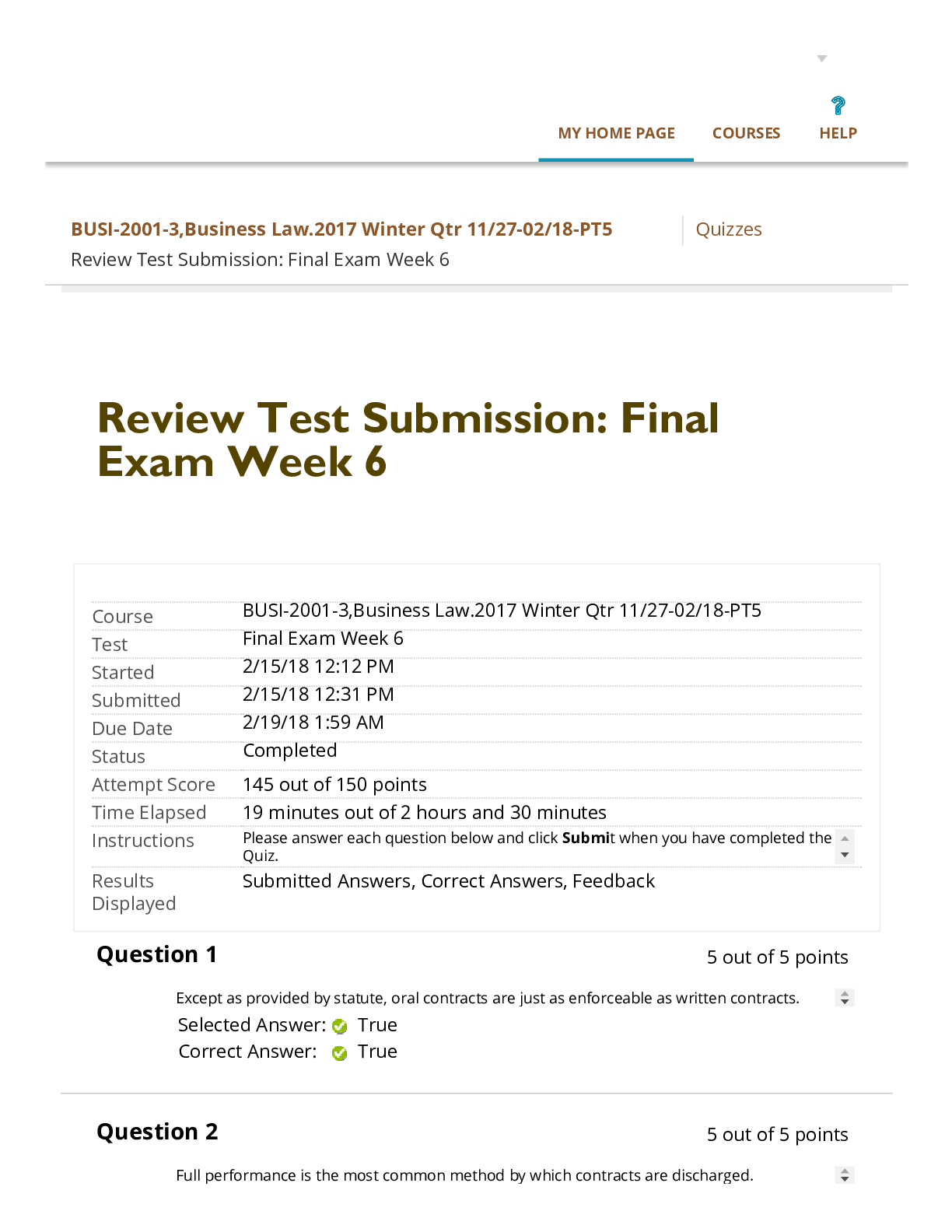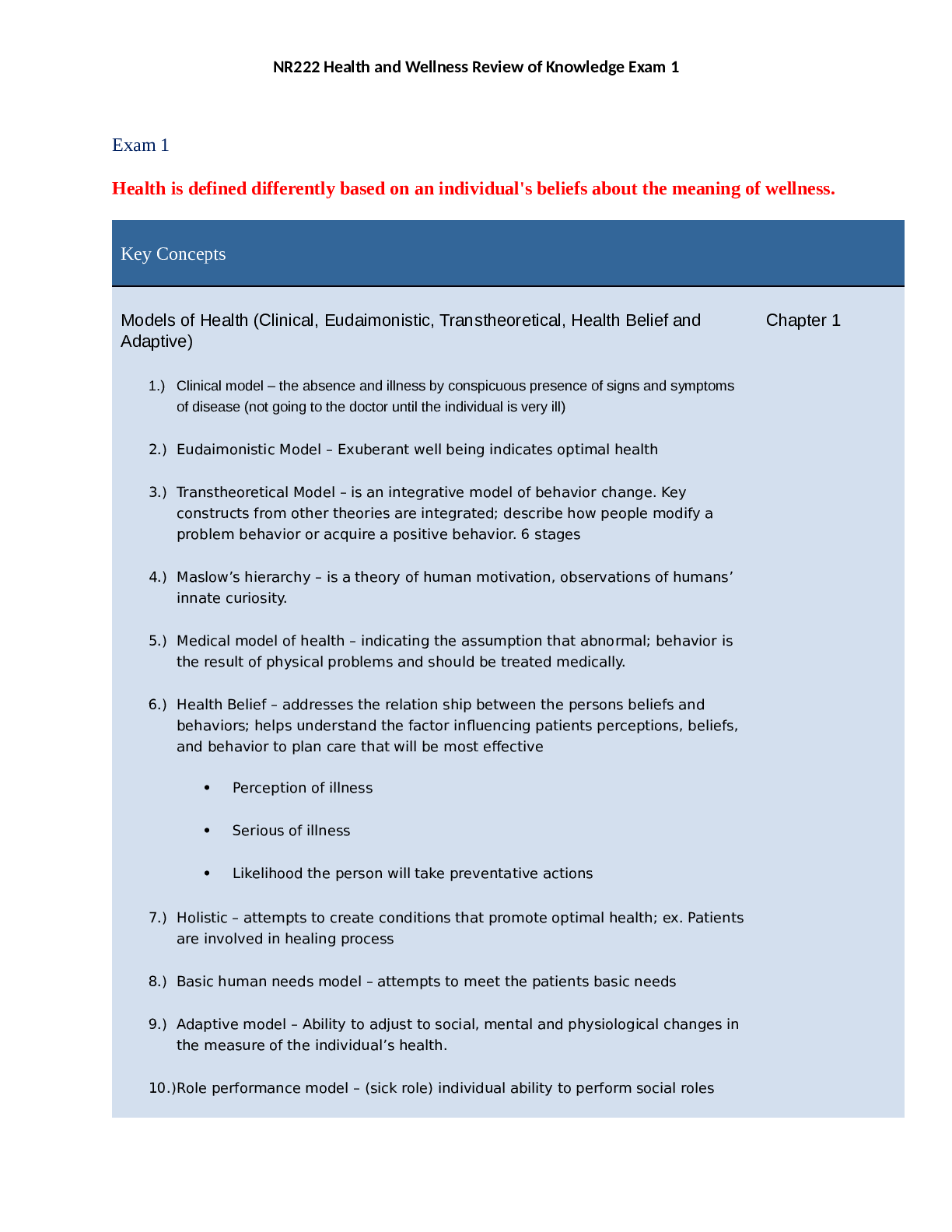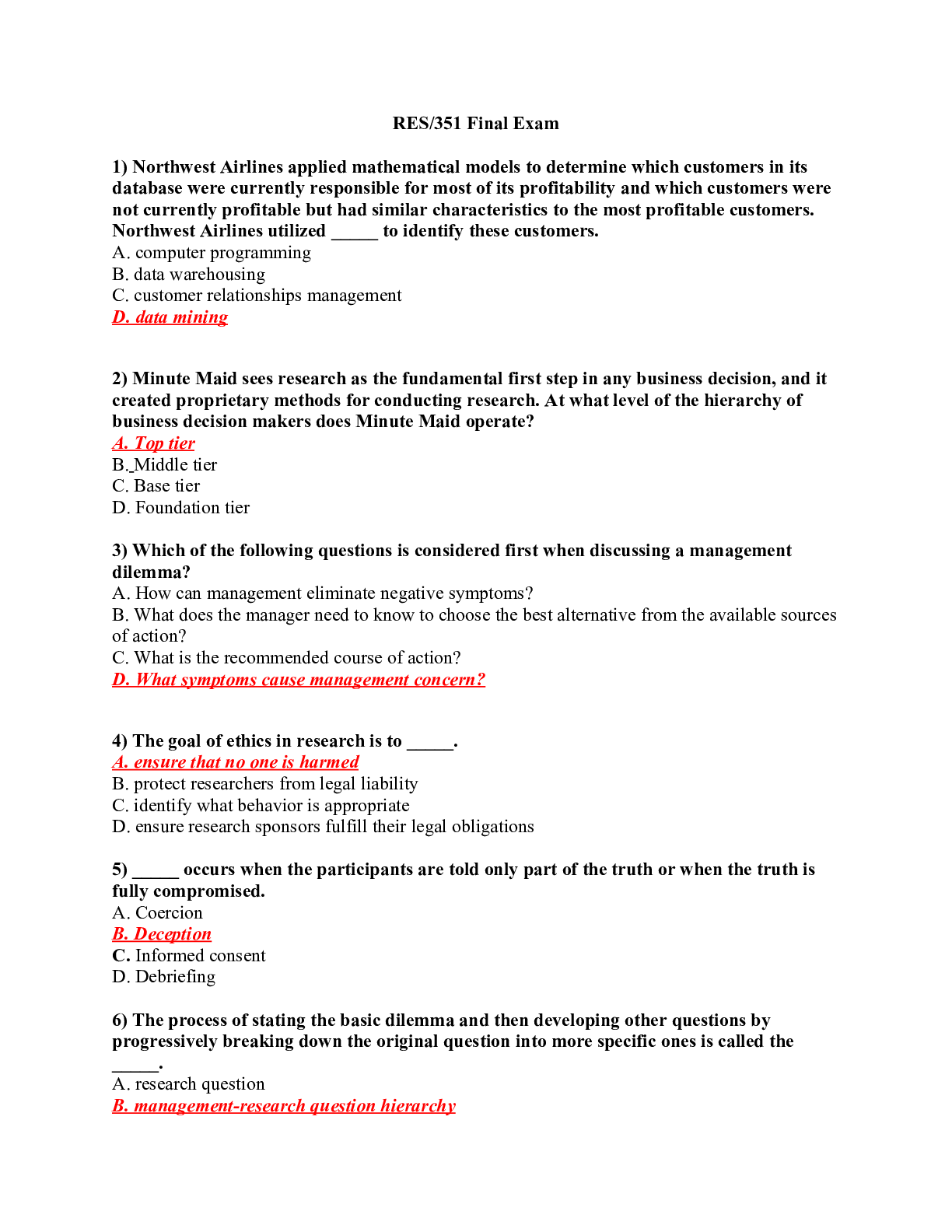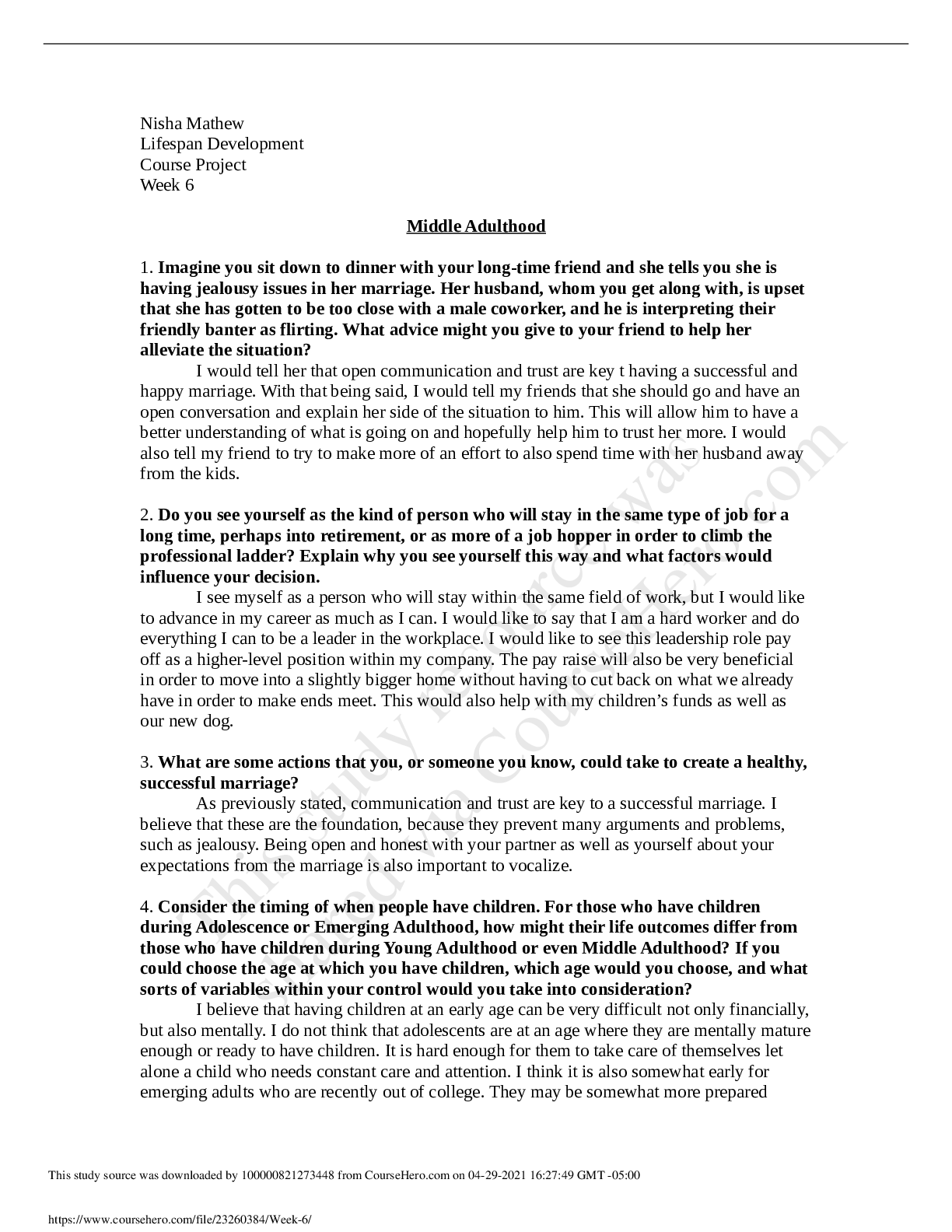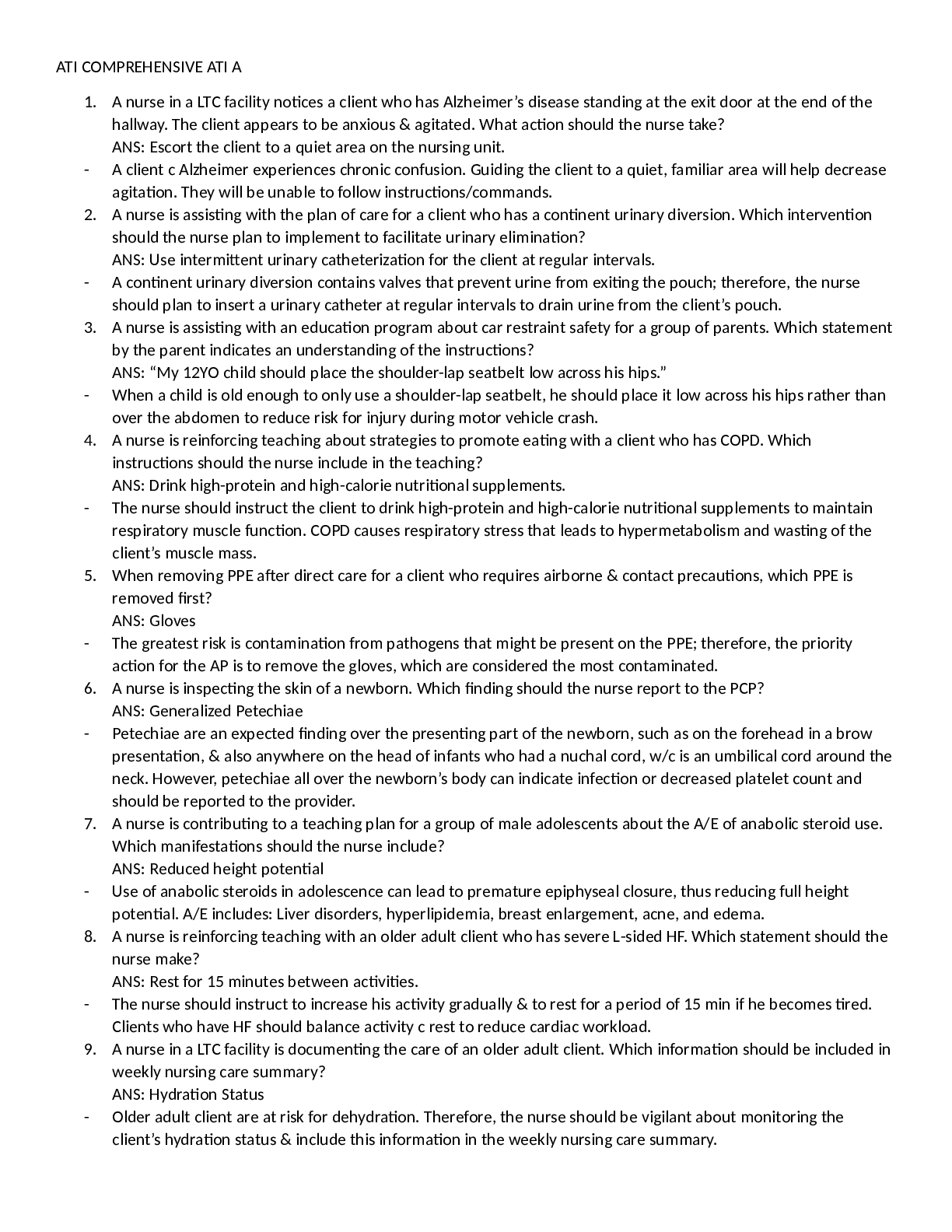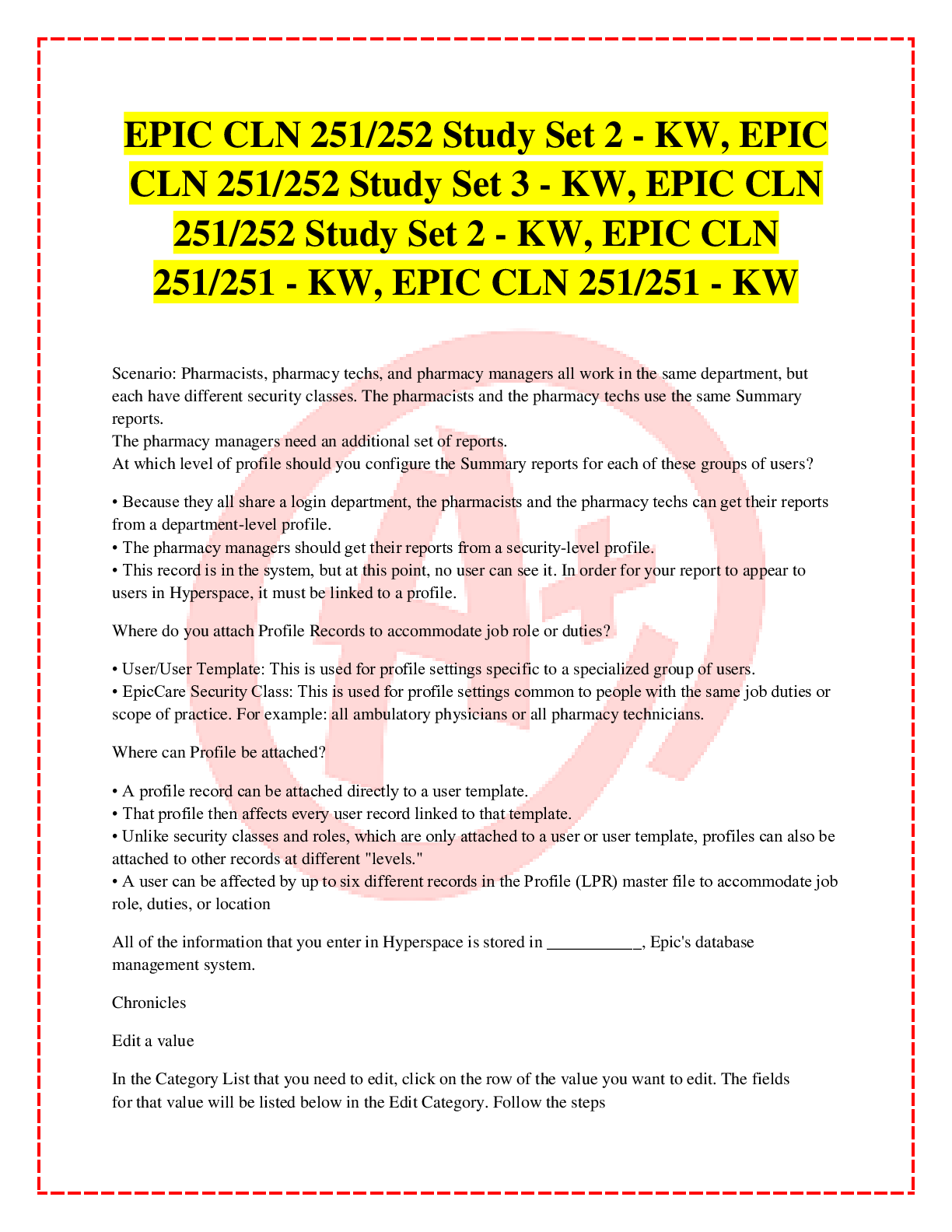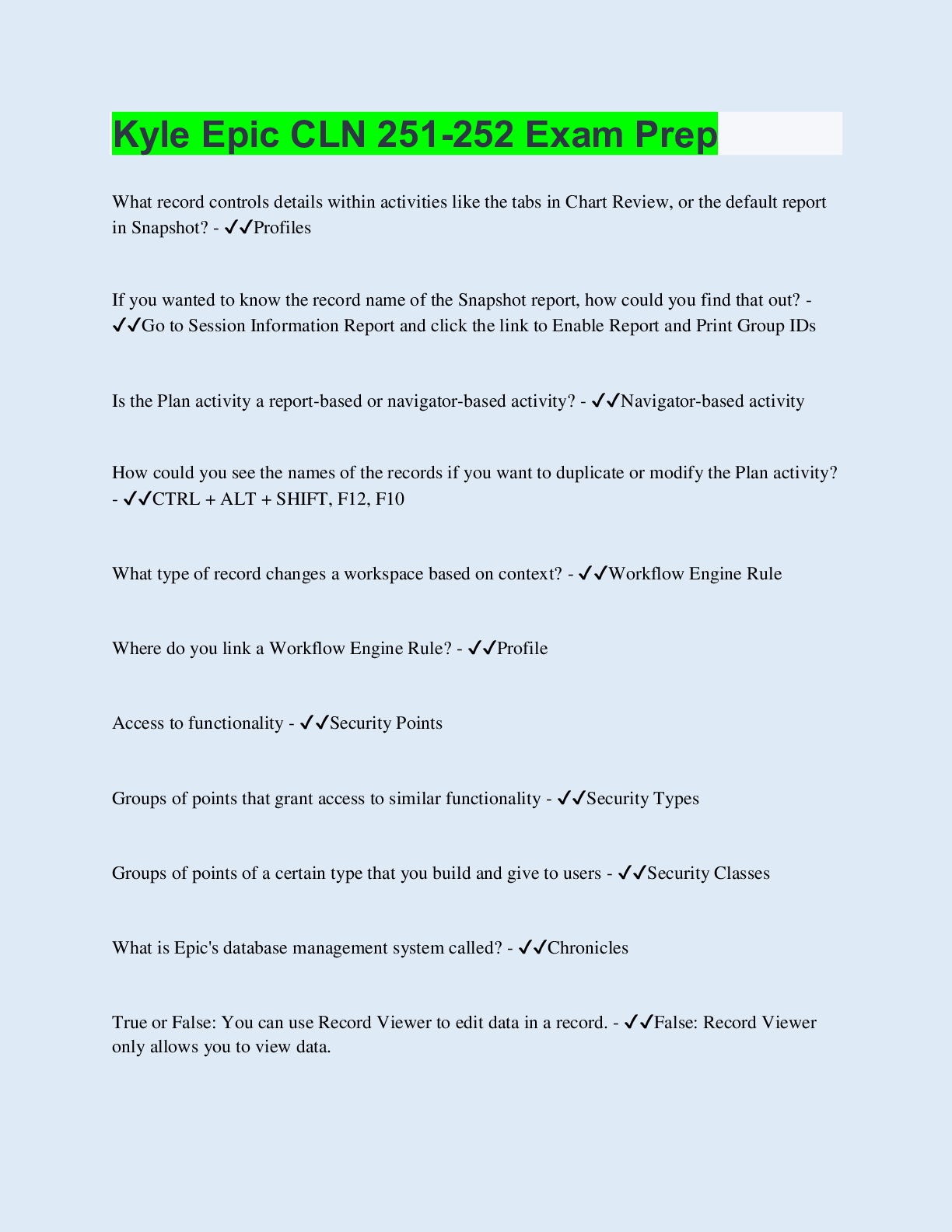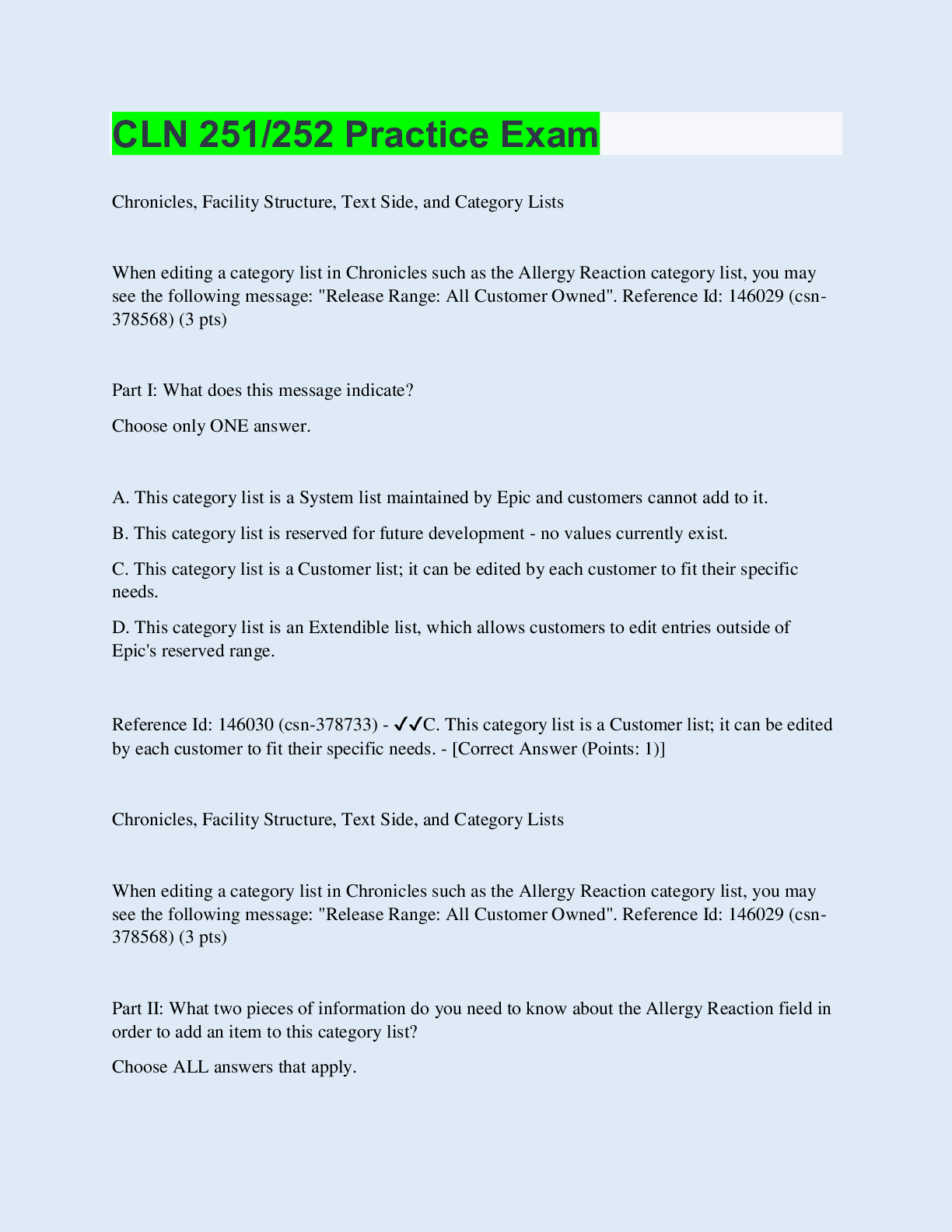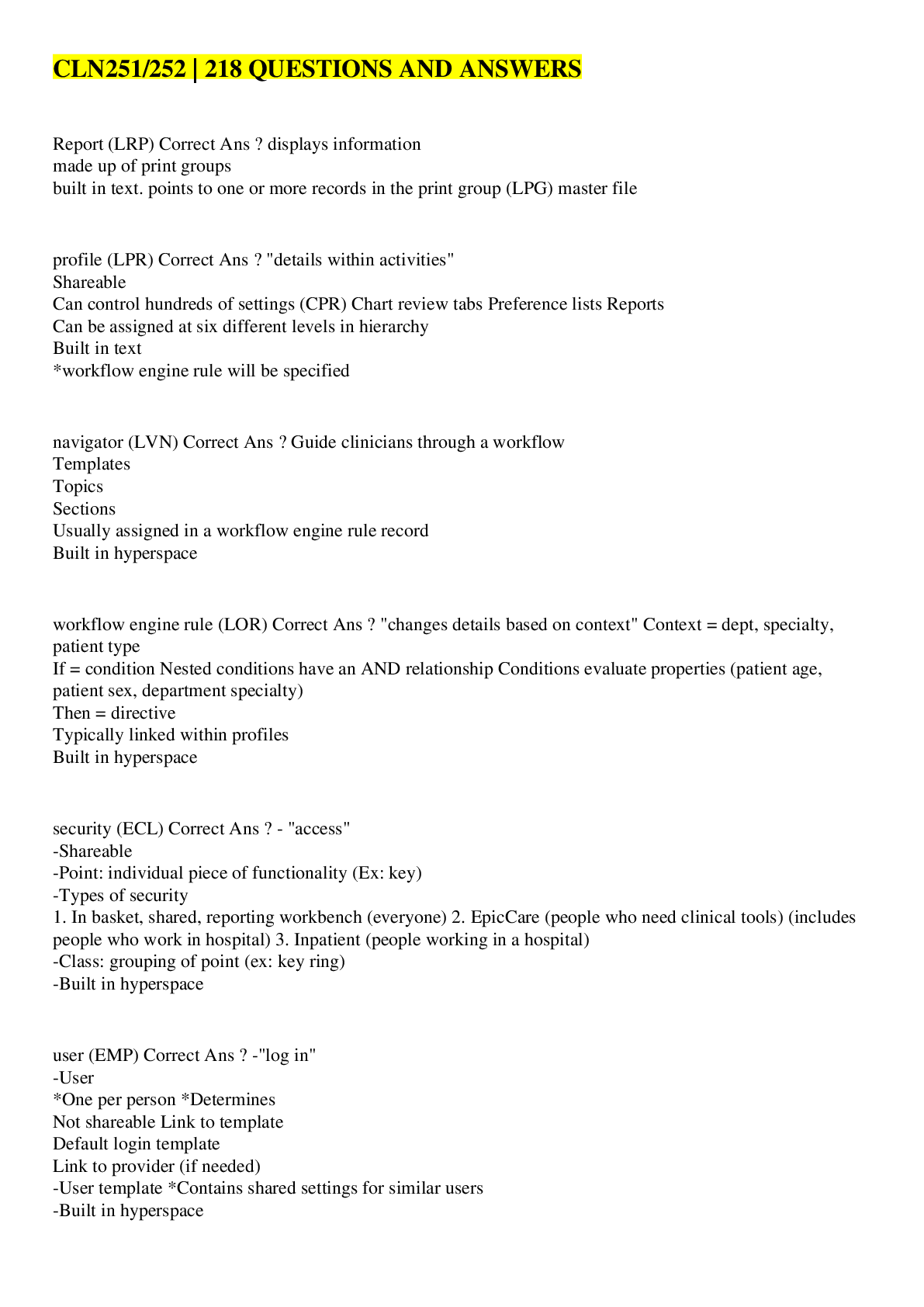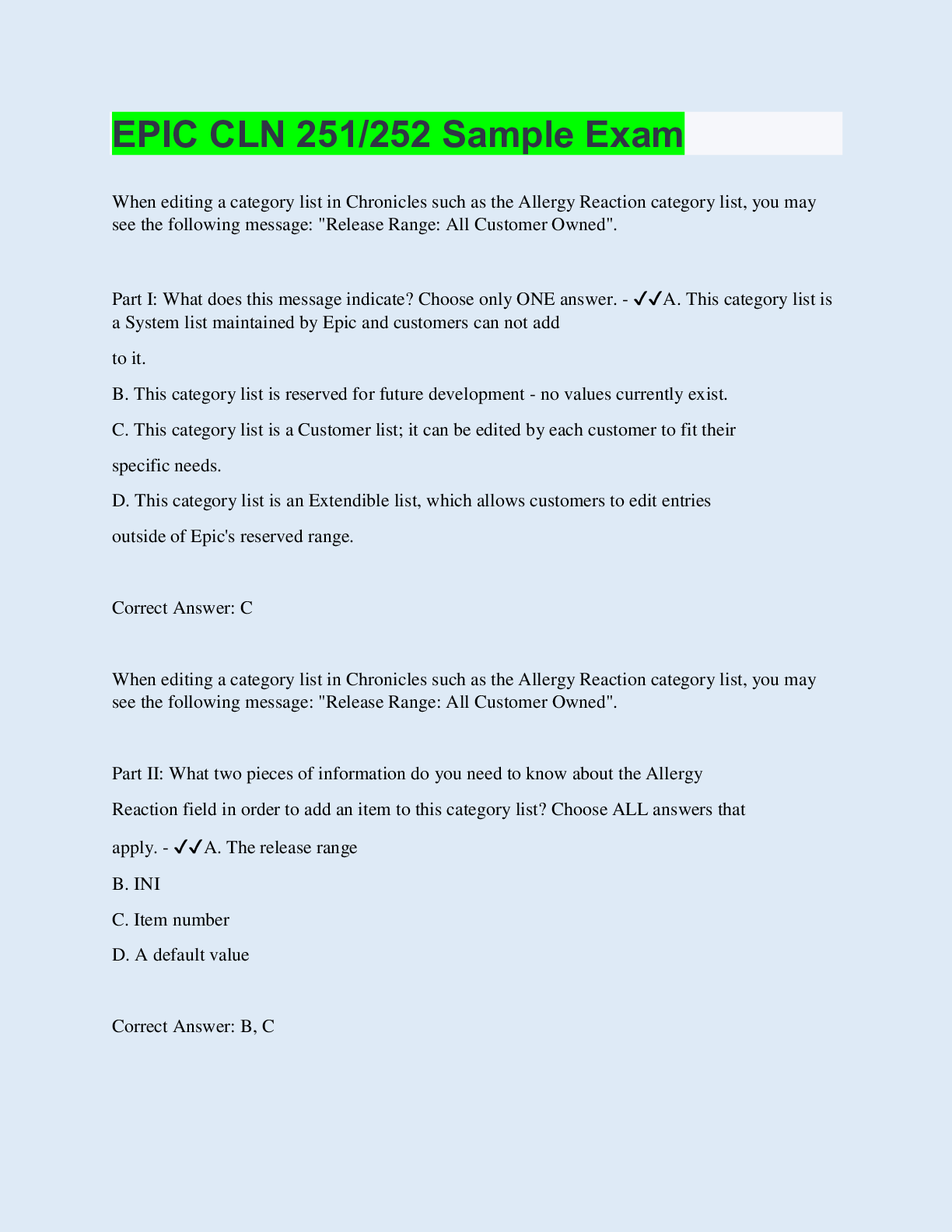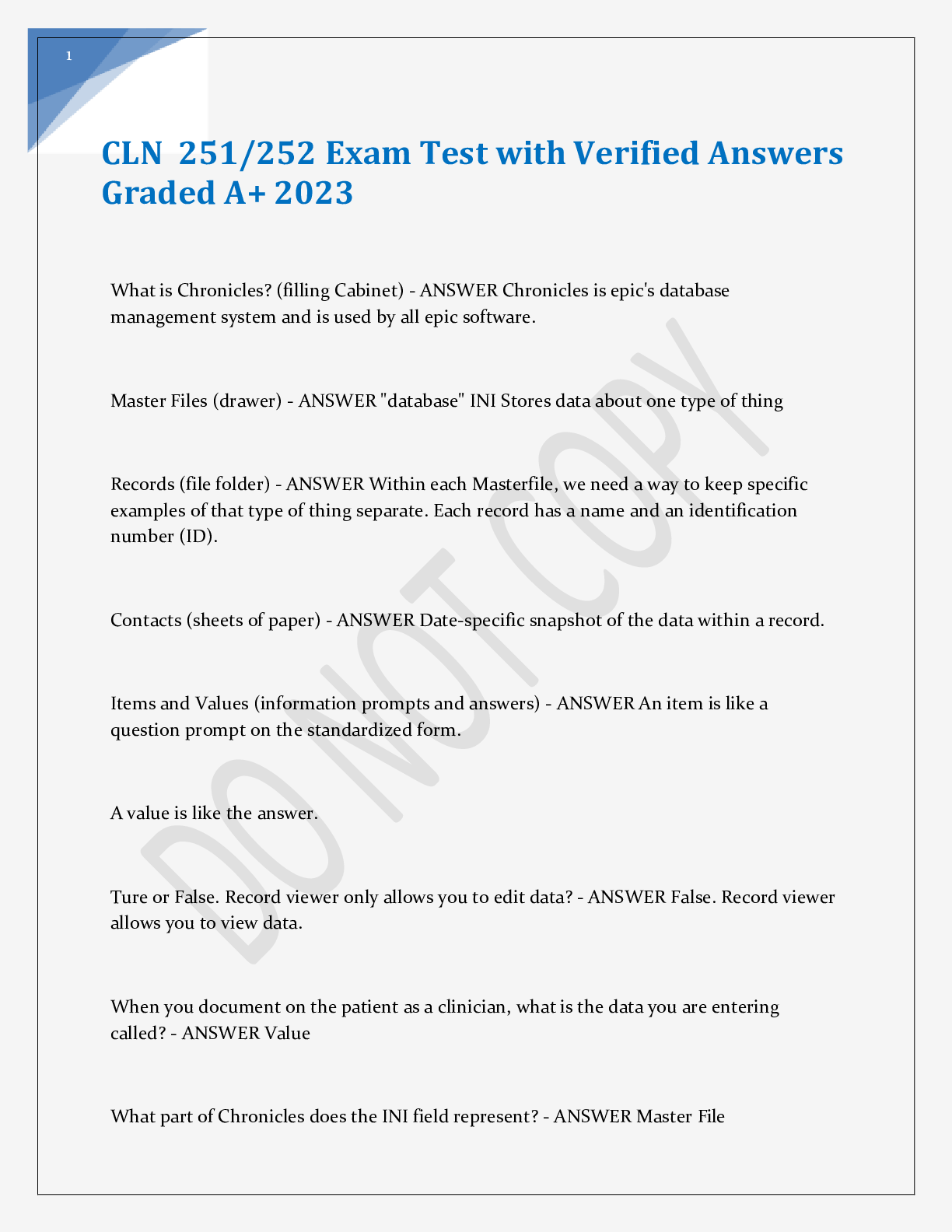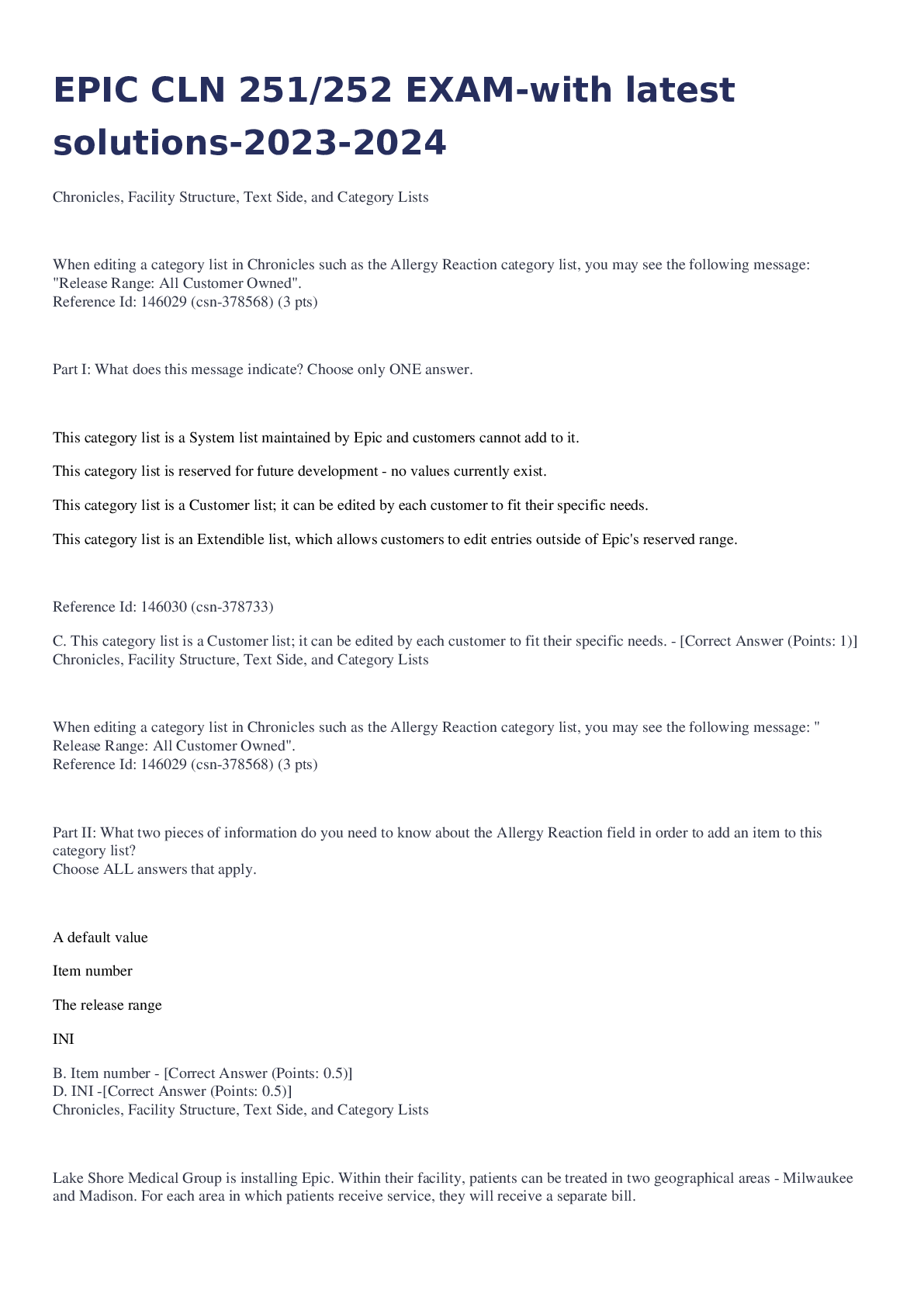NUR 1022Cweek 7 bowel and ostomy
Document Content and Description Below
NUR 1022Cweek 7 bowel and ostomy Bowel movements: What are the contraindicatons for enemas? Contraindicatons for enemas include increased intracranial pressure, glaucoma, and rectal or prostate sur... gery. Administering an enema to clients who have any of these conditons can lead to serious complicatons. Check the client’s history prior to administraton of an enema to be sure they do not have any problem that might make enema administraton unsafe. What should I assess before I give a client an enema? Assess eliminaton status by checking the client’s normal eliminaton patern, last bowel movement, pain, ability to ambulate, structural abnormalites, and sphincter control. The nurse should also complete an abdominal assessment. 1. The nurse is preparing the administer a cleansing enema to a client who has poor sphincter control. Which of the following actons should the nurse take? A. Place the client in the dorsal recumbent positon on a bedpan. * B. Administer the enema while the client sits on the toilet. C. Administer and antdiarrheal medicaton 3 hours prior to the enema. D. Instll 200 mL of fluid over and hour at 15-minutes intervals. 2. A nurse is preparing an adult client or and enema. The nurse should assist the client into which of the following positons? A. Prone B. Doral recumbent C. Right lateral with both knees at chest D. Lef lateral with the right leg flexed.* 3. A nurse is administering an enema medicaton with sodium polystyrene sulfonate to an adult client who has hyperkalemia. To which of the following lengths should the nurse insert the rectal tube? A. 2.5 cm to 3.75 cm (1 to 1.5 in) B. 5 cm to 7.5 cm (2 to 3 in) C. 7.5 cm to 10 cm (3 to 4 in)* D. 10 cm to 12.5 cm (4 to 5 in) 4. A nurse is preparing to administer the frst of two large-volume, cleansing enemas prescribed for a client in preparaton for a diagnostc procedure. Which of the following actons should the nurse take? A. Warm the enema soluton prior to instllaton.* B. Prepare 1,500 mL of enema fluid. C. Use tap water as the enema fluid. D. Hang the enema container 24 inches above the anus. 5. A nurse is administering a return-flow enema to a client. Afer instlling 100 mL enema fluid, which of the following actons should the nurse take. A. Instruct the client to retain the fluid. B. Lower the container to allow the soluton to flow back out. * C. Help the client to the toilet of bedside commode. D. Wait 5 minutes and instll another 100mL of fluid. This study source was downloaded by 100000826504961 from CourseHero.com on 06-20-2022 06:09:05 GMT -05:00 https://www.coursehero.com/file/89693505/week-7-bowel-and-ostomydocx/6. A nurse is preparing to administer an oil retenton enema to a client who has constpaton. The nurse should instruct the client to retain the soluton for which of the following duratons? A. The duraton of the procedure. B. 10 to 15 minutes C. Untl the client feels the urge to defecate. D. At least 30 minutes. * 7. While a nurse is administering a cleansing enema, the client reports abdominal cramping. Which of the following actons should the nurse take? A. Measure the client’s vitals. B. Notfy the primary care provider. C. Lower the enema fluid container. * D. Stop the enema instllaton. 8. A client who is postoperatve is experiencing abdominal distenton and is having difculty expelling flatus. The nurse should expect the provider to prescribe which of the following types of enemas? A. Cleansing. B. Return-flow. * C. Medicated. D. Oil-retenton. Ostomy Care: Ostomies may be temporary or permanent. 4 colostomy placements: Ascending colon (right abdomen)- liquid to semi-liquid, very irritatng to surrounding skin; Transverse colon (midabdomen)- for temporary ostomy- pasty output; Descending colon (lef upper abdomen)- semi-formed due to more water absorpton while fecal mater is in the ascending and transverse colon; Sigmoid colon (lef lower abdomen)- permanent colostomy, usually for rectum/rectal cancer, stoma will be on lower lef quadrant, output if formed. Peristomal skin: the skin surrounding an ostomy. Colostomy: Surgical formaton of an opening from the colon to the surface of the body. End colostomy: The damaged secton of the bowel is removed, and the working end is brought through the abdomen to the skin surface. Hartmann’s pouch: A common temporary colostomy surgery involves leaving the distal porton of the colon in place, which is oversewn for closure. Loop colostomy: A loop of the bowel is brought through the abdomen to the skin surface and temporarily supported by a plastc bridge or rod. A transverse loop colostomy is typically created as an emergency procedure to relieve an intestnal obstructon or perforaton. It has two openings through the one stoma; the proximal end (drains stool) and the distal bowel (drains mucus). Double-barrel colostomy: Two separate stomas are created, both ends of the bowel are brought through the abdomen to the skin surface as two separate sectons. Typically, the distal colon is not removed but bypassed. The proximal stoma, which is functonal, diverts feces to the abdominal wall. The distal carries no fecal contents. Ileostomy: Surgical creaton of an external opening into the ileum to bypass the large intestne. Stoma placement is typically in the right lower quadrant. IPAA: Ileal Pouch Anal Anastomosis-restoratve proctocolectomy- connects the ileum to a new rectum (or anal pouch), made from the ileum. Kock’s contnent ileostomy: an alternatve to the standard ileostomy. This is created during the procedure, an internal pouch Is created from the distal segment of the ileum, which serves as a reservoir for stool. This is a one-way nipple valve through the stomal opening and through the one way valve to drain the fecal mater contents of the internal pouch. This is created to treat ulceratve colits, as an opton for patents who don’t wish to have an external pouch. Higher complicaton rate than traditonal ileostomy. Stoma cap. Stoma: A surgically created opening in the skin of the abdomen. This study source was downloaded by 100000826504961 from CourseHero.com on 06-20-2022 06:09:05 GMT -05:00 https://www.coursehero.com/file/89693505/week-7-bowel-and-ostomydocx/Anastomosis: Surgical connecton between two structures. It most ofen means a connecton that is created between tubular structures, such as blood vessels or loops of intestne. Indicatons for ostomy surgery include: Congenital anomalies; bladder, colon, and rectal cancer; inflammatory bowel disease (Crohn’s, ulceratve colits); inherited disorders; obstructon of the ureter; stab or gunshot wounds to the abdomen. Afer inital postoperatve period, regular died can be resumed (fresh fruits and vegetables, protein sources, and whole-grain bread and cereals). Loose stool and flatus causing foods: chocolate, dried beans, friend foods, highly spiced foods, and raw fruits and vegetables. Hard to digest foods: stringy vegetables, coconut, coleslaw, mushrooms, popcorn, seeds, berries, celery, fresh tomatoes. Foods that thicken the bowel (if runny): applesauce, bananas, cheese, pasta, and rice. Odor causing foods: asparagus, beans, cabbage, eggs, fsh, garlic, onions, some spices. Gas causing foods: beer, broccoli, Brussel sprouts, cabbage, carbonated drinks, cauliflower, corn, cucumbers, dairy products, dried beans, mushrooms, onions, peas, and radishes. Food to avoid (to prevent blockage): popcorn, nuts, corn, celery, fresh tomatoes, fgs, strawberries, blackberries, and caraway seeds. Speak to doctor or take care to use: laxatves, enemas (fluid imbalance), enteric-coated and substance release medicatons. Clients who have an ileostomy are at a higher risk of fluid and electrolyte imbalances due o shorter transit tme through the bowel, decreased absorpton of fluid and nutrients, and a higher volume of efuent. High-volume ileostomy output warnings: Extreme thirst, dry skin and oral mucus membranes, decreased urine output, weakness, fatgue, headache, dizziness, muscle cramps, abdominal cramps, nausea, vomitng, shortness of breath, orthostatc hypotension. Skin barrier: Protectve artfcial layer placed over skin to protect it and help maintain skin integrity. Patents must learn the signs of food blockage and when to contact their doctors. Cramping, nausea, vomitng, swelling of the stoma, and ileostomy output for at least 6 hours. Patents will need to lay down and assume a knee-chest positon to relieve intra-abdominal pressure, and/or massage the abdominal are to promote peristalsis and fecal eliminaton. Urostomy: a urinary diversion that allows urine to exit the body afer removal of a diseased or damaged secton of the urinary tract. Ileal conduit: Isolated segment of ileum that serves as a substtuton for the urinary bladder. Ureters are implanted, and the lumen is connected to the skin. This requires a loop of intestnal ileum. Ureterostomy: Surgical creaton of an external opening in the abdominal wall through which the ureter are diverted. There are not restrictons for a urostomy but foods that cause odor are alcohol, asparagus, dried beans, broccoli, Brussel sprouts, cabbage, cauliflower, cheese, eggs, fsh, and onions. Draining and ostomy pouch: during least actve bowel tmes, place protectve pad underneath ostomy to keep environment clean. Remove clip from ostomy keeping it tlted up. Roll back the top of the ostomy back to ensure clean edges and reduce smell and infecton. Squeeze ostomy back downward into container. Replacing and ostomy pouching system: (min 2-7 days) during least actve bowel tme, start at one corner start separatng barrier from the skin while holding the skin, moving in a circle. Use mild soap with warm water to clean residue and prep from new pouch, pat dry. Remove gloves, hand hygiene, new gloves. Inspect stoma, red and moist. Find which size is needed, trace size on prepared covering. Make sure skin is dry and atach skin barrier, place on skin by applying pressure evenly while going around the barrier for best grip. Connect pouch to skin barrier by applying pressure untl it snaps into place. Remind patent to stay in place for 5 minutes for best adherence. Closed end pouches: one tme use and may meet the needs of a client who irrigates. Some pouches come with a flter to reduce odor and gas buildup. This pouch has no drain clip, best for sigmoid colostomies. Drainable pouches: they can be rinsed and reused, best for ascending or transverse colostomy, ileostomy, and urostomy. Drainable urostomy pouches have a tap instead of a clip. Colostomy irrigaton: Set up irrigaton bag with warm water and prescribed soluton mixture. Dawn gloves, gown, and mask with or without shield. Remove pouch and clean off fecal mater. Atach irrigaton sleeve. Use a cone to direct the water into the stoma. Apply lubricant soluton to reduce irritaton, water soluble. Insert cone into the top opening into the irrigaton bag and gently push into the stoma. Unlink the irrigaton fluid and allow to flow slowly. Leave in 5-10 minutes for full effect. Hydronephrosis: Enlargement of the kidneys as urine collects in the renewal pelvis and the kidney tssue. Mucocutaneous separaton: Separaton of the stoma from the peristomal skin. Dermatts: Inflammaton of the skin. This study source was downloaded by 100000826504961 from CourseHero.com on 06-20-2022 06:09:05 GMT -05:00 https://www.coursehero.com/file/89693505/week-7-bowel-and-ostomydocx/Irritant dermatts: Cause- Contact with stool or urine, usually from leakage under the pouching system or between the skin barrier and the stoma/ Descripton- Reddened, moist, painful skin. Treatment- Clean and dry peristomal skin. Use a protectve skin barrier powder or wipe the skin before applying the skin barrier. Remeasure the stoma to ensure use of the correct size pouch and/or skin barrier. Allergic contact dermatts: Cause- Exposure to materials and chemical compounds that irritate the skin on contact (tape, soap, skin barriers, adhesives, powders, pastes, pouch material. Descripton- Redness and irritaton in the are covered or treated with product. Treatment- Alter the pouching system or skin care procedure to eliminate the irritatng product. Yeast infectons (candidiasis): Cause- Leakage, perspiraton, antbiotc, therapy, or broken skin. Descripton- Itchy, bumpy, reddened skin. Treatment- Apply topical antfungal powder. Keep the skin clean and dry. 1. A nurse is teaching a client who has bladder cancer about urinary diversion optons. The nurse should inform the client that which of the following optons will allow them to have come control over urinary eliminaton? A. Kock’s pouch.* B. Ileal conduit. C. Cutaneous ureterostomy. D. Nephrostomy. 2. A nurse is teaching a client who has a new ileostomy about preventng the excoriaton and breakdown of the peristomal skin afer they have returned home. Which of the following instructons should the nurse include? A. Apply hydrocortsone cream to the skin when changing the appliance. B. Empty the pouch when it is less than half full.* C. Wash the peristomal skin frequently with deodorizing soap and water. D. Choose a tme shortly afer a meal for replacing the pouch. 3. A nurse is obtaining health history from a client who has a colostomy. The client reports frequent episodes of loose stools over the last month but has no signs of infecton or bowel obstructon. The client tells the nurse that they have avoided partcipaton in social actvites because they are concerned about leakage. Which of the following should the nurse recommend? A. Consume foods that are low in fber content.* B. Take an ounce of mineral oil twice daily. C. Add butermilk and cranberry juice to the diet. D. Increase water intake to 3 to 3.5 L per day. 4. A nurse is teaching a client about extended-wear skin barriers. Which of the following strategies should the nurse instruct the clients to use for maximal adherence? A. Use an oil-based loton on the peristomal area. B. Apply the skin barrier while the skin is slightly moist. C. Leave the residue from the previous appliance on the skin. D. Press gently around the barrier for 30 seconds to 1 minute.* 5. A nurse is reinforcing teaching with a client about replacing an ostomy pouching system. The client reports that they occasionally experience pain when removing the skin barrier. Which of the following technique should the nurse suggest? A. Life up on both sides of the skin barrier simultaneously. B. Release one corner of the barrier and pull it quickly over the stoma. C. Push the skin away from the barrier while removing it.* This study source was downloaded by 100000826504961 from CourseHero.com on 06-20-2022 06:09:05 GMT -05:00 D. Gently roll the barrier end-over-end across the stoma. https://www.coursehero.com/file/89693505/week-7-bowel-and-ostomydocx/6. A nurse is replacing the ostomy appliance from a client whose newly created colostomy is functoning. Afer removing the pouch, which of the following actons should the nurse take frst? A. Measure the stoma. B. Cover the stoma with gauze. C. Remove the backing on the skin barrier. D. Cleanse the stoma and the peristomal skin. * 7. A nurse is reinforcing teaching with a client who has colon cancer and is scheduled for a procedure to remove their entre large intestne and rectum. The nurse should reinforce with the client that they are schedule for which of the following types of ostomy procedure? A. Cecostomy. B. Loop colostomy. C. Ileostomy. * D. Descending colostomy. 8. A nurse is providing preoperatve teaching for a client who is scheduled for creaton of a sigmoid colostomy. Which of the following informaton should the nurse include in the teaching? A. Expect the efuent from the sigmoid colostomy to be loose and contnuous. B. Use irrigaton to help establish a regular bowel patern. * C. Change the stoma’s appliance every other day. D. Expect efuent from the newly created stoma within 24 hours afer surgery. [Show More]
Last updated: 1 year ago
Preview 1 out of 5 pages

Reviews( 0 )
Document information
Connected school, study & course
About the document
Uploaded On
Nov 08, 2022
Number of pages
5
Written in
Additional information
This document has been written for:
Uploaded
Nov 08, 2022
Downloads
0
Views
90



